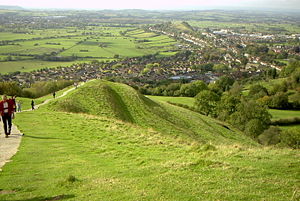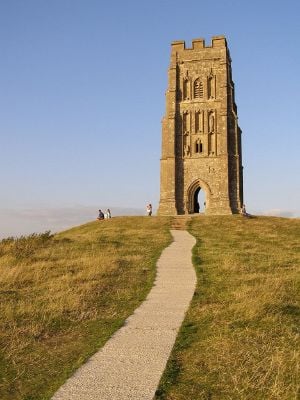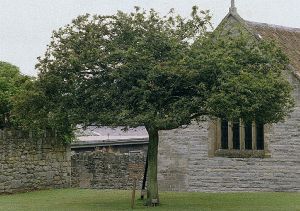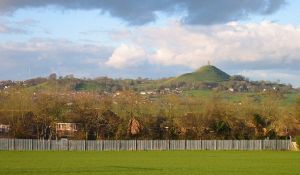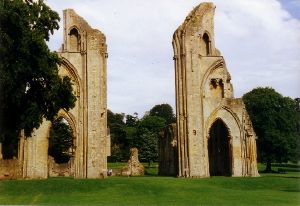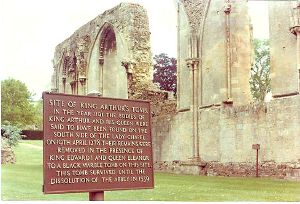Difference between revisions of "Glastonbury" - New World Encyclopedia
Mary Anglin (talk | contribs) |
Rosie Tanabe (talk | contribs) m |
||
| (20 intermediate revisions by 7 users not shown) | |||
| Line 1: | Line 1: | ||
| − | {{Images OK}}{{ | + | {{Approved}}{{Submitted}}{{Images OK}}{{Paid}}{{Copyedited}} |
| − | + | [[Image:Glastenburytor glastoburyview.jpg|thumb|300px|Overlooking the town of Glastonbury from Glastonbury Tor]] | |
| − | | | + | '''Glastonbury''' is a small [[England|English]] town famed for its ancient [[Monasticism|monastic]] sites and legendary connections to historic figures, both religious and royal. A gravitational center for legendary activity, Glastonbury, which lies among the ditches and low meadows of the [[Somerset Level]], has a population of 8,800 inhabitants. The small patch of land has been a pilgrimage site for hundreds of years, with spiritual seekers drawn to its ancient ruins, including sites such as Glastonbury Lake Village, Glastonbury Abbey and Glastonbury Tor. The Glastonbury Festival takes place annually in the nearby village of Pilton. Glastonbury is also said to be the center of several [[ley line]]s. |
| − | | | ||
| − | | | + | It is believed that [[Arthur|King Arthur]] and [[Queen Guinevere]] not only resided in the town, but were laid to rest there. The monastery of Glastonbury is believed by many to have held the [[Holy Grail]]. [[Joseph of Arimathea]], according to tradition, visited Glastonbury, once with the still young [[Jesus]]. This particular legend inspired the words to the most patriotic of English songs, "Jerusalem," which asks the question |
| + | :"And did those feet in ancient time walk upon England’s mountains green?" | ||
| + | {{Toc}} | ||
| + | ==History== | ||
| + | [[Image:Summit of glastonbury tor.jpg|thumb|Remains of St. Michael's Church at the summit of Glastonbury Tor.]] | ||
| + | [[Image:Glastonbury Thorn.jpg|thumb|right|Holy Thorn, Glastonbury Abbey.]] | ||
| + | [[Image:Glastonbury_Tor_060404.jpg|right|thumbnail|Glastonbury Tor from the nearby town of Street.]][[Image:Glastonburyabbey.jpg|thumb|right|Ruins of Glastonbury Abbey]]. | ||
| + | [[Image:KingArthurTombsite.jpg|thumb|King Arthur's Tomb.]] | ||
| + | The origins of Glastonbury are deeply rooted in myth and [[religion|religious]] affiliation. According to the prevailing [[mythology]], the Somerset plain was once a swampy, wet terrain unsuitable for human occupation. The only area in the region that was suitable for settlement, according to this myth, was the high land of Glastonbury. As the most attractive location, the elevated plot of land hosted [[Ancient Rome|Roman]]s, [[Saxon]]s, and an early abbey. | ||
| − | + | According to the early church tradition [[Joseph of Arimathea]] was a tin trader and as such visited Cornwall, the world’s main source of tin until recently. After the death of Joseph, Mary’s husband, – Joseph of Arimathea took care of Jesus and took him on his visits to Britain. Jesus built a hut at Glastonbury where he lived. [[St. Augustine]] wrote a letter to Rome confirming this after he was sent to England by the Pope. | |
| − | |||
| − | |||
| − | |||
| − | |||
| − | + | The [[Joseph of Arimathea]] legend relates to the idea that Glastonbury was the birthplace of [[Christianity]] in the British Isles, and that the first British [[church]] was built there at Joseph's behest to house the [[Holy Grail]], 30 or so years after the death of [[Jesus]]. The legend also says that earlier Joseph had visited Glastonbury along with Jesus as a child. The legend probably has its origins in the [[mediaeval]] period when religious relics and pilgrimages were profitable business for abbeys. However [[William Blake]] believed in this legend and wrote the poem that became the words to the most patriotic of English songs, 'Jerusalem' (see [[And did those feet in ancient time]]). | |
| − | |||
| − | |||
| − | |||
| − | |||
| − | |||
| − | |||
| − | |||
| − | The | + | The growth of the monastery was fueled by the multitude of myths surrounding the nearby hill, [[Glastonbury Tor]]. Many pilgrims who sought guidance at the monastery of Glastonbury also sought time on the hill, which was believed by many to hold the [[Holy Grail]]. According to myth, Joseph of Arimathea hid the holy grail in a small church built on the hill. Believers in this version of Glastonbury history hold that the small church built by Joseph was the first [[Christian]] Church in [[England]]. Under this idea, Glastonbury Tor is seen as the birthplace of British Christianity. |
| − | + | As the center of the town, the abbey came to dominate life in Glastonbury. Industry in particular was supported by the expanding [[monastery]], as the church began to support the development of tanners and other craftsmen in the area to provide much needed supplies for the abbey. The abbey continued to expand until 1184, when a savage fire destroyed much of the development. A small portion of those monastic remains still exist. | |
| − | + | One particularly prominent myth in the Glastonbury story regards the [[Glastonbury Thorn]] (or Holy Thorn). According to legend, Joseph of Arimathea arrived at the monastery at a time when the wet Somerset Levels were only passable by [[boat]]. Arriving on the shores of Glastonbury, the [[legend]] states that he placed his staff, grown from Christ's Holy Crown of Thorns, on the shore to steady his step. From where this sacred staff hit the ground of Glastonbury, a small thorny bush sprung up. Many feel that the presence of the Crataegus hawthorn tree in Glastonbury confirms this particular myth, as it is found nowhere else in the world. | |
| − | + | One version of the legend relates that [[Jesus]], while a boy, accompanied by Joseph of Arimathea, travelled to Glastonbury. This is linked with an idea from the [[Book of Revelation]] that describes a [[Second Coming]] in which Jesus establishes a new Jerusalem. Consequently the Christian Church in general, and the English Church in particular, used [[Jerusalem]] as a metaphor for heaven. [[William Blake]] knew of the legend, and whether or not he believed it, he was inspired to write the poem that became the words to the most patriotic of English songs, "Jerusalem." | |
| + | The text is as follows: | ||
| + | :And did those feet in ancient time | ||
| + | ::walk upon England’s mountains green? | ||
| + | :And was the holy Lamb of God | ||
| + | ::on England’s pleasant pastures seen? | ||
| + | :And did the countenance divine | ||
| + | ::shine forth upon our clouded hills? | ||
| + | :And was Jerusalem builded here | ||
| + | ::among these dark Satanic Mills? | ||
| − | + | :Bring me my bow of burning gold! | |
| − | + | ::Bring me my arrows of desire! | |
| − | + | :Bring me my spear! O clouds, unfold! | |
| − | + | ::Bring me my chariot of fire! | |
| − | + | :I will not cease from mental fight, | |
| − | + | ::nor shall my sword sleep in my hand, | |
| − | + | :till we have built Jerusalem | |
| − | + | ::In England’s green and pleasant Land. | |
| − | |||
| − | |||
| − | |||
| − | |||
| − | + | While many of the myths about Glastonbury history focus on the role of Joseph of Arimathea in contributing to the town, a mythological counterpart exists that supports the idea that it was [[King Arthur]], not Joseph of Arimathea, that contributed the most to the town. According to this mythological camp, Glastonbury is the modern manifestation of the mythical city of [[Avalon]], where Arthur and [[Guinevere]] were laid to rest. Accounts also claim that [[Lancelot]] sought the refuge of Glastonbury Abbey after the death of King Arthur. | |
| − | + | Fueled by the legacy of myth, Glastonbury continues to attract hordes of tourists annually who strive to reconnect with ancient times. Most of the tourists seek the ruins of the Abbey, which are still open to visitors. Only small portions of the original structures remain however, due both to the fire that ravaged the town in the early 12th century and to the tendency for local builders to use abandoned stones when building modern structures. The Abbot's Kitchen and Lady's Chapel are two strongly preserved edifices. | |
| − | + | ==Culture and People== | |
| − | + | Glastonbury is an eclectic mix of inhabitants: those who have lived their whole life in Glastonbury, those who have moved to Glastonbury to escape the fast-paced world, and those who are drawn by the spiritual legacy of the city. Priding itself on its vibrant and dynamic character, Glastonbury plays host to many independent thinkers who are simply trying to escape the outside world. Many of the artistic sort who frequent Glastonbury flock to the city during the annual Glastonbury Festival. | |
| − | Glastonbury | ||
| − | Glastonbury | + | The [[hippie]] generation of the 1960s and 1970s also contributed heavily to establishing Glastonbury as a center for [[New Age|alternative religious]] study. The [[Summer solstice|summer solstice]] of 1971 was a particularly poignant moment in the alternative history of Glastonbury, as nearby hills flooded with people attempting to experience the season change at the mythological site. This mass gathering of spiritual individuals is often compared with [[Woodstock]] in the [[United States]] for the sheer number of attendees and alternative ideas. |
| − | + | Since the late 1990s, Glastonbury has also hosted an annual ''Glastonbury Symposium for Crop Circles and Signs of our Time,'' where attendees attempt to unravel the symbols behind [[crop circle]]s and similar physical structures. Conferences like the Symposium for Crop Circles are commonly hosted in Glastonbury, and the crop circle enthusiasts are joined by the ''Goddess Convention,'' the ''Avalon Pipers,'' and an assortment of psychedelic rock bands who experience Glastonbury as a friendly meeting place. | |
| − | + | ==Economy == | |
| − | The local | + | The economy of Glastonbury maintains many of the characteristics of a traditional market town: local produce is still prominent and market exchange takes place in small scale relationships. Key agricultural products in the lower elevations, that are necessarily more damp, include [[peat]] and [[withes]] for basket making. Herds of [[cattle]] are still a common site roaming the hills of Glastonbury, and the [[milk]] drawn from the herds is used to make [[Cheddar Cheese]], the region's distinct type of [[cheese]]. |
| − | + | In the higher elevations of Glastonbury, where the air is drier, [[strawberry|strawberries]] and [[apple]] orchards dot the landscape. Another common site in the less damp regions is field after field of [[grape]] vines. [[Vineyard]]s have always been a typical agricultural crop of the region, with some historians claiming that the crop can be traced to Roman times. | |
| − | |||
| − | |||
| − | |||
| − | |||
| − | |||
| − | |||
| − | + | The nearby village of Street has blossomed from its humble beginnings as a market town into an industrial center. Street is particularly noted for its export of [[leather]] shoes by the Clarks family. Despite becoming an export center, however, Street maintains its small town feeling, reassuring many that the encroachments of the future will not change the character of life in Glastonbury. | |
| − | + | ==References== | |
| − | |||
| − | |||
| − | + | * Ashe, Geoffrey. 1958. ''King Arthur's Avalon; the story of Glastonbury.'' New York: Dutton. | |
| − | + | * Costantino, Maria. 2001. ''The Illustrated Flag Handbook.'' New York: Gramercy Books. ISBN 0517218100 | |
| − | * | + | * ''Great Britain (Eyewitness Guide).'' New York: DK Publishing. ISBN 0756615429 |
| + | * Lewis, Brenda Ralph. 2002. ''Great Civilizations.'' Bath, UK: Parragon Publishing. ISBN 0752561413 | ||
| − | |||
| − | |||
| − | |||
| − | |||
| − | |||
==External links== | ==External links== | ||
| − | * [http://www.glastonbury.gov.uk/ | + | All links retrieved June 23, 2017. |
| − | + | * [http://www.glastonbury.gov.uk/ Website of Glastonbury Town Council] | |
* [http://www.isleofavalon.co.uk/ Isle of Avalon] | * [http://www.isleofavalon.co.uk/ Isle of Avalon] | ||
* [http://libraryofavalon.co.uk/ Library of Avalon ''(specialist esoterica)''] | * [http://libraryofavalon.co.uk/ Library of Avalon ''(specialist esoterica)''] | ||
| − | * [http://www.glastonburypilgrimage.com/ Glastonbury Pilgrimage Association], Annual Christian pilgrimage led by local churches | + | * [http://www.glastonburypilgrimage.com/ Glastonbury Pilgrimage Association], Annual Christian pilgrimage led by local churches |
| − | * [http://www.glastonbury-pilgrim.co.uk/ Glastonbury Pilgrim Reception Centre] Support and advice for pilgrims researching their visit to Glastonbury | + | * [http://www.glastonbury-pilgrim.co.uk/ Glastonbury Pilgrim Reception Centre] Support and advice for pilgrims researching their visit to Glastonbury |
| − | + | * [http://www.british-history.ac.uk/report.asp?compid=40921 Benedictine Abbey of Glastonbury] A History of the County of Somerset: Vol 2: (1911) | |
| − | * [http://www.british-history.ac.uk/report.asp?compid=40921 Benedictine Abbey of Glastonbury] A History of the County of Somerset: Vol 2: (1911) | + | |
| − | |||
| − | {{credit|150166752}} | + | {{credit|Glastonbury|150166752|And_did_those_feet_in_ancient_time|178256592}} |
[[Category:Geography]] | [[Category:Geography]] | ||
[[Category:Europe]] | [[Category:Europe]] | ||
[[Category:History]] | [[Category:History]] | ||
| + | [[Category:Sites of religious pilgrimages]] | ||
Latest revision as of 16:09, 23 June 2017
Glastonbury is a small English town famed for its ancient monastic sites and legendary connections to historic figures, both religious and royal. A gravitational center for legendary activity, Glastonbury, which lies among the ditches and low meadows of the Somerset Level, has a population of 8,800 inhabitants. The small patch of land has been a pilgrimage site for hundreds of years, with spiritual seekers drawn to its ancient ruins, including sites such as Glastonbury Lake Village, Glastonbury Abbey and Glastonbury Tor. The Glastonbury Festival takes place annually in the nearby village of Pilton. Glastonbury is also said to be the center of several ley lines.
It is believed that King Arthur and Queen Guinevere not only resided in the town, but were laid to rest there. The monastery of Glastonbury is believed by many to have held the Holy Grail. Joseph of Arimathea, according to tradition, visited Glastonbury, once with the still young Jesus. This particular legend inspired the words to the most patriotic of English songs, "Jerusalem," which asks the question
- "And did those feet in ancient time walk upon England’s mountains green?"
History
.
The origins of Glastonbury are deeply rooted in myth and religious affiliation. According to the prevailing mythology, the Somerset plain was once a swampy, wet terrain unsuitable for human occupation. The only area in the region that was suitable for settlement, according to this myth, was the high land of Glastonbury. As the most attractive location, the elevated plot of land hosted Romans, Saxons, and an early abbey.
According to the early church tradition Joseph of Arimathea was a tin trader and as such visited Cornwall, the world’s main source of tin until recently. After the death of Joseph, Mary’s husband, – Joseph of Arimathea took care of Jesus and took him on his visits to Britain. Jesus built a hut at Glastonbury where he lived. St. Augustine wrote a letter to Rome confirming this after he was sent to England by the Pope.
The Joseph of Arimathea legend relates to the idea that Glastonbury was the birthplace of Christianity in the British Isles, and that the first British church was built there at Joseph's behest to house the Holy Grail, 30 or so years after the death of Jesus. The legend also says that earlier Joseph had visited Glastonbury along with Jesus as a child. The legend probably has its origins in the mediaeval period when religious relics and pilgrimages were profitable business for abbeys. However William Blake believed in this legend and wrote the poem that became the words to the most patriotic of English songs, 'Jerusalem' (see And did those feet in ancient time).
The growth of the monastery was fueled by the multitude of myths surrounding the nearby hill, Glastonbury Tor. Many pilgrims who sought guidance at the monastery of Glastonbury also sought time on the hill, which was believed by many to hold the Holy Grail. According to myth, Joseph of Arimathea hid the holy grail in a small church built on the hill. Believers in this version of Glastonbury history hold that the small church built by Joseph was the first Christian Church in England. Under this idea, Glastonbury Tor is seen as the birthplace of British Christianity.
As the center of the town, the abbey came to dominate life in Glastonbury. Industry in particular was supported by the expanding monastery, as the church began to support the development of tanners and other craftsmen in the area to provide much needed supplies for the abbey. The abbey continued to expand until 1184, when a savage fire destroyed much of the development. A small portion of those monastic remains still exist.
One particularly prominent myth in the Glastonbury story regards the Glastonbury Thorn (or Holy Thorn). According to legend, Joseph of Arimathea arrived at the monastery at a time when the wet Somerset Levels were only passable by boat. Arriving on the shores of Glastonbury, the legend states that he placed his staff, grown from Christ's Holy Crown of Thorns, on the shore to steady his step. From where this sacred staff hit the ground of Glastonbury, a small thorny bush sprung up. Many feel that the presence of the Crataegus hawthorn tree in Glastonbury confirms this particular myth, as it is found nowhere else in the world.
One version of the legend relates that Jesus, while a boy, accompanied by Joseph of Arimathea, travelled to Glastonbury. This is linked with an idea from the Book of Revelation that describes a Second Coming in which Jesus establishes a new Jerusalem. Consequently the Christian Church in general, and the English Church in particular, used Jerusalem as a metaphor for heaven. William Blake knew of the legend, and whether or not he believed it, he was inspired to write the poem that became the words to the most patriotic of English songs, "Jerusalem." The text is as follows:
- And did those feet in ancient time
- walk upon England’s mountains green?
- And was the holy Lamb of God
- on England’s pleasant pastures seen?
- And did the countenance divine
- shine forth upon our clouded hills?
- And was Jerusalem builded here
- among these dark Satanic Mills?
- Bring me my bow of burning gold!
- Bring me my arrows of desire!
- Bring me my spear! O clouds, unfold!
- Bring me my chariot of fire!
- I will not cease from mental fight,
- nor shall my sword sleep in my hand,
- till we have built Jerusalem
- In England’s green and pleasant Land.
While many of the myths about Glastonbury history focus on the role of Joseph of Arimathea in contributing to the town, a mythological counterpart exists that supports the idea that it was King Arthur, not Joseph of Arimathea, that contributed the most to the town. According to this mythological camp, Glastonbury is the modern manifestation of the mythical city of Avalon, where Arthur and Guinevere were laid to rest. Accounts also claim that Lancelot sought the refuge of Glastonbury Abbey after the death of King Arthur.
Fueled by the legacy of myth, Glastonbury continues to attract hordes of tourists annually who strive to reconnect with ancient times. Most of the tourists seek the ruins of the Abbey, which are still open to visitors. Only small portions of the original structures remain however, due both to the fire that ravaged the town in the early 12th century and to the tendency for local builders to use abandoned stones when building modern structures. The Abbot's Kitchen and Lady's Chapel are two strongly preserved edifices.
Culture and People
Glastonbury is an eclectic mix of inhabitants: those who have lived their whole life in Glastonbury, those who have moved to Glastonbury to escape the fast-paced world, and those who are drawn by the spiritual legacy of the city. Priding itself on its vibrant and dynamic character, Glastonbury plays host to many independent thinkers who are simply trying to escape the outside world. Many of the artistic sort who frequent Glastonbury flock to the city during the annual Glastonbury Festival.
The hippie generation of the 1960s and 1970s also contributed heavily to establishing Glastonbury as a center for alternative religious study. The summer solstice of 1971 was a particularly poignant moment in the alternative history of Glastonbury, as nearby hills flooded with people attempting to experience the season change at the mythological site. This mass gathering of spiritual individuals is often compared with Woodstock in the United States for the sheer number of attendees and alternative ideas.
Since the late 1990s, Glastonbury has also hosted an annual Glastonbury Symposium for Crop Circles and Signs of our Time, where attendees attempt to unravel the symbols behind crop circles and similar physical structures. Conferences like the Symposium for Crop Circles are commonly hosted in Glastonbury, and the crop circle enthusiasts are joined by the Goddess Convention, the Avalon Pipers, and an assortment of psychedelic rock bands who experience Glastonbury as a friendly meeting place.
Economy
The economy of Glastonbury maintains many of the characteristics of a traditional market town: local produce is still prominent and market exchange takes place in small scale relationships. Key agricultural products in the lower elevations, that are necessarily more damp, include peat and withes for basket making. Herds of cattle are still a common site roaming the hills of Glastonbury, and the milk drawn from the herds is used to make Cheddar Cheese, the region's distinct type of cheese.
In the higher elevations of Glastonbury, where the air is drier, strawberries and apple orchards dot the landscape. Another common site in the less damp regions is field after field of grape vines. Vineyards have always been a typical agricultural crop of the region, with some historians claiming that the crop can be traced to Roman times.
The nearby village of Street has blossomed from its humble beginnings as a market town into an industrial center. Street is particularly noted for its export of leather shoes by the Clarks family. Despite becoming an export center, however, Street maintains its small town feeling, reassuring many that the encroachments of the future will not change the character of life in Glastonbury.
ReferencesISBN links support NWE through referral fees
- Ashe, Geoffrey. 1958. King Arthur's Avalon; the story of Glastonbury. New York: Dutton.
- Costantino, Maria. 2001. The Illustrated Flag Handbook. New York: Gramercy Books. ISBN 0517218100
- Great Britain (Eyewitness Guide). New York: DK Publishing. ISBN 0756615429
- Lewis, Brenda Ralph. 2002. Great Civilizations. Bath, UK: Parragon Publishing. ISBN 0752561413
External links
All links retrieved June 23, 2017.
- Website of Glastonbury Town Council
- Isle of Avalon
- Library of Avalon (specialist esoterica)
- Glastonbury Pilgrimage Association, Annual Christian pilgrimage led by local churches
- Glastonbury Pilgrim Reception Centre Support and advice for pilgrims researching their visit to Glastonbury
- Benedictine Abbey of Glastonbury A History of the County of Somerset: Vol 2: (1911)
Credits
New World Encyclopedia writers and editors rewrote and completed the Wikipedia article in accordance with New World Encyclopedia standards. This article abides by terms of the Creative Commons CC-by-sa 3.0 License (CC-by-sa), which may be used and disseminated with proper attribution. Credit is due under the terms of this license that can reference both the New World Encyclopedia contributors and the selfless volunteer contributors of the Wikimedia Foundation. To cite this article click here for a list of acceptable citing formats.The history of earlier contributions by wikipedians is accessible to researchers here:
The history of this article since it was imported to New World Encyclopedia:
Note: Some restrictions may apply to use of individual images which are separately licensed.
